A history of Midland Sailing Club – Part 1
The beginning of Midland Sailing Club on Edgbaston Reservoir.
In the early 2010’s a statement in the club magazine “Mainsheet” lead one of our most long-standing members, Alan Birch, to do a little research. The statement was that in 1894 Midland Sailing Club was “only open to the great and the good (our first Commodore was the Earl of Dudley)”.
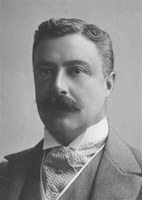
Alan says that after reading this statement in Mainsheet he “was intrigued” because when he wrote the historical notes for the opening of the new Club-house in 1967 he found the following in the first minute book of the club: “On the 11th. June, 1894 at the offices of Mr Cecil Crosskey at 32 Waterloo Street Birmingham Dr Kauffmann proposed “a sailing club be formed with headquarters in Birmingham” and it was seconded by Mr J.Storer. The founder members present at that meeting were : Mssrs. C. Crosskey; J. Storer ; J. Osler; J. W. Ryland; Dr. Kauffmann; L.W. Mathews; L.B. Chatwin.” Following is the first of Alan Birch’s History of the Sailing Club.
Following is the first of Alan Birch’s History of the Sailing Club.
 I wondered at the time what manner of folk they were (the founder members). Were they really the great and good? Stimulated, I recently spent a morning on the fifth floor of Birmingham Central Library delving into old press cuttings and found, at least, some of the answer. This is what I have discovered so far about our founders. Most were aged in their twenties to my surprise.
I wondered at the time what manner of folk they were (the founder members). Were they really the great and good? Stimulated, I recently spent a morning on the fifth floor of Birmingham Central Library delving into old press cuttings and found, at least, some of the answer. This is what I have discovered so far about our founders. Most were aged in their twenties to my surprise.
Dr Kauffmann (1863-1934) was appointed Hon. Physician to out patients at the Queens Hospital in 1892. He later had a very distinguished medical career becoming Professor of Medicine at Birmingham University.
L.B.Chatwin (1872-1933) was educated at K.E.S. Birmingham and went to Merton College, Oxford. He trained as a solicitor at Ryland Martineau (now Martineaus). At Oxford he had been a member of the Oxford University Yacht Club. After the First World War he was a founder member of Barnt Green Sailing S.C. He was very keen on amateur dramatics. He is the grandfather of travel writer Bruce Chatwin.
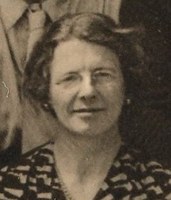 I could not find out much about Julian Osler apart from the fact that he, too, was very interested in acting but also mountaineering. Apparently he climbed regularly with William Mathews, also a solicitor and his father Charles Matthews. They were members of the Birmingham Alpinists. Julian climbed in Wales with the redoubtable Dr Dorothy Jordan Lloyd who became the first lady to climb the Eiger. The Oslers were a well known Birmingham family, and his mother Catherine (who got married in Crosskey’s Church of the Messiah) was active in the Birmingham Women’s Suffrage Society. Julian himself was a member of the Men’s League For Women’s Suffrage.
I could not find out much about Julian Osler apart from the fact that he, too, was very interested in acting but also mountaineering. Apparently he climbed regularly with William Mathews, also a solicitor and his father Charles Matthews. They were members of the Birmingham Alpinists. Julian climbed in Wales with the redoubtable Dr Dorothy Jordan Lloyd who became the first lady to climb the Eiger. The Oslers were a well known Birmingham family, and his mother Catherine (who got married in Crosskey’s Church of the Messiah) was active in the Birmingham Women’s Suffrage Society. Julian himself was a member of the Men’s League For Women’s Suffrage.
Cecil Crosskey (1859-1945) was also a solicitor. He was the son of the Minister of the Church of the Messiah and had been articled at Ryland Martineau. He had served in the South African War and presumably had only just got back. He later became a Lt. Colonel in WW1 and received an OBE in 1919.
It was difficult to find much about James Storer, although I know from other sources that he was still active in the Club in 1922. An 1881 census search found only 2 James Storers in Warwickshire, one of whom was“boarding” in Ladywood, aged 23. He was described as a butcher. I think that was him and believe he probably was “in trade” in Edgbaston by 1894.
J.W.Ryland is the main conundrum. There was such an initialled prominent Birmingham manufacturer, who was into everything although he lived at Rowington. He died in 1896. He was Chairman of Llewellyn Ryland of Balsall Heath, paint manufacturers. He would have been very much older than the rest. I can find mention of a William Ryland who also worked for Ryland Martineau but not a J.W. Ryland. Perhaps J.W.Ryland is William Ryland.
It was on 25th, February, 1895 at the first AGM that the Earl of Dudley was invited to become Commodore. I suspect that this might have been because he was Chairman of the Birmingham Canal Navigations, the then owners of the Reservoir, but in the time available I couldn’t substantiate this. However I did discover that he was a keen yachtsman and regularly sailed with the then Prince of Wales, later Edward VII, in “big boats”!
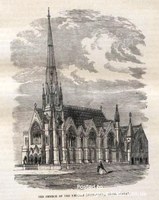 My researches did discover another connection. The second Commodore was Sir Charles Hyde (1876-1942). Apparently Lt. Col. Crosskey met Sir Charles Hyde during the Boer War and they were afterwards both trustees of the South African War Benevolent Fund. He was the owner of the Birmingham Post. Sir Charles was a founder member of the Royal Cruising Club so he too was a yachtsman. He was a generous benefactor to the University Medical School.
My researches did discover another connection. The second Commodore was Sir Charles Hyde (1876-1942). Apparently Lt. Col. Crosskey met Sir Charles Hyde during the Boer War and they were afterwards both trustees of the South African War Benevolent Fund. He was the owner of the Birmingham Post. Sir Charles was a founder member of the Royal Cruising Club so he too was a yachtsman. He was a generous benefactor to the University Medical School.
There are two other interesting themes that presented themselves. A number of the founder members were Unitarian Church of the Messiah in Broad Street. Secondly all, except Storer, were part of the closely intermarried Birmingham industrial and professional classes of the day. They were not great, like the Earl of Dudley who was later Governor General of Ireland and later Australia, but their families were good and Birmingham owes a great deal to the parents of our founder members. And, of course, we the present members owe a great debt of gratitude to Kauffmann et al. for starting our Club.
A history of the MSC – Part 2
First races.
According to an article in the “Helm” in 1922, written by founder member, James Storer, racing took place at 6pm on Friday 18th May 1894 and that there was a strong breeze from the north north east. There was race on the following Tuesday, 29th May 1894. In what you might ask!
I already knew that Salters of Oxford, known by “googling” to be a firm still in existence, had a concession on the Tower Ballroom side of the Reservoir and wondered whether they could throw any light on this question. Amazingly an e-mail produced a reply by return stating that my query had been passed onto a Simon Wenham who is writing a thesis on Salters for his history Ph.D.
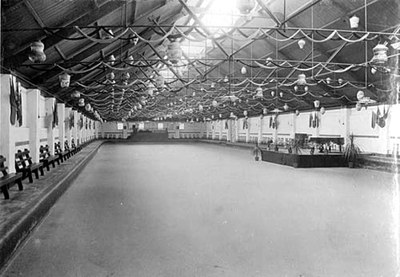 Simon responded promptly and stated that Salters had a concession from 1892 until 1930, hiring out boats, having a steam boat for trips round the “Rez” and constructing a roller skating rink where the Tower Ballroom now is.
Simon responded promptly and stated that Salters had a concession from 1892 until 1930, hiring out boats, having a steam boat for trips round the “Rez” and constructing a roller skating rink where the Tower Ballroom now is.
He also said that the records show that there was a severe drought in 1893 and Salters obtained a reduction in rent from the Canal Co. and in the 1894/5 winter the Reservoir froze over and payments were made to charity from the fees taken. Some problems never go away!!
Armed with this information I returned to Birmingham Central Library’s archive department and sought information on the “Rez” and Salters. To my amazement an original copy of Salters 1899 programme was produced. Unfortunately I was not allowed to copy all of it because of the Copyright Act but the archivist allowed me to copy a double page which shows that boats were available for hire; a picture of one such sailing boat; and mention that the “Rez” was home to the Birmingham Rowing Club (founded 1893) and the Midland Sailing Club. There is also a copy of the 1900 programme in a series of articles about Birmingham which has a photo of the skating rink and details of events in that year.
 I, therefore, think it is safe to assume that the first races were held in boats hired from Salters as stated by Storer in his article. He says the boats were “Lily, Sylph and Wasp” hired from Salters and “Stork”, a sailing canoe, which he owned. They were joined by “Crocodile”, a sharpie built and owned by L.B.Chatwin for the race on Tuesday 29th May 1894.
I, therefore, think it is safe to assume that the first races were held in boats hired from Salters as stated by Storer in his article. He says the boats were “Lily, Sylph and Wasp” hired from Salters and “Stork”, a sailing canoe, which he owned. They were joined by “Crocodile”, a sharpie built and owned by L.B.Chatwin for the race on Tuesday 29th May 1894.
A third race was held on Thursday 7th June but the names of the boats taking part are not mentioned.
After the initial meeting on Monday 11th June 1894 things moved on quickly. At the first meeting of the Committee four new members were invited to join the Club and the design of the Club Burgee was decided upon. The subscription was fixed at 2s. and 6 pence from each member and the Secretary was asked to draw up racing rules based on those of the Royal Canoe Club.
On Wednesday 22nd. November 1894 the first annual dinner took place. Seems they had a busy time! There was a lot of discussion to determine if the Club should have a one design class. Eventually seven boats were ordered from Mr Henry Holford of Gloucester and delivered for the 1896 season. They were 12ft oa., beam of 4ft. 6″ and cost complete on rail at Gloucester £13.5.0 each. Storer states that since the Club now had enough boats, hiring was discontinued and the race day changed to Saturday.
 That might have been so but the photo of the yacht race in 1910 shows una rigged boats whereas the one designs were sloops. There is a sloop in Creek. Perhaps this race is early in the season and members have hired if their boats were not ready: or perhaps the sloop rig had proved unsuitable and they had been re-rigged as una craft.
That might have been so but the photo of the yacht race in 1910 shows una rigged boats whereas the one designs were sloops. There is a sloop in Creek. Perhaps this race is early in the season and members have hired if their boats were not ready: or perhaps the sloop rig had proved unsuitable and they had been re-rigged as una craft.
This may have been so because a postcard taken in 1905 clearly shows the hire craft and they have a different una rig. Storer states there were a number of other boats as well, mainly sharpies, and that by 1905 there were often 15 boats on moorings. So by then, the Club was well established and it was time for the building of a Clubhouse, not where the Club is now, but on the bank on the far side to the left of the Ranger’s Office near Reservoir Road.
A history of the MSC – Part 3
1901—1917
Peter Waine sent me this copy of the menu for the 1901 Annual Dinner. It illustrates two notable features of the early years, apart from the sumptuous menu which must have cost a fortune.
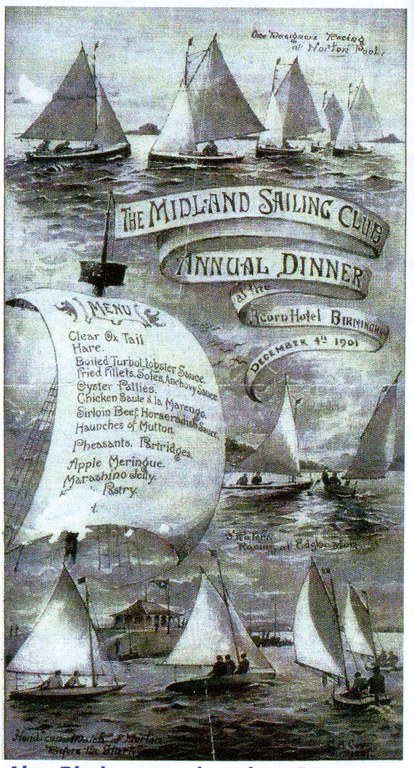 First notice that the top illustration is of “One Designers” racing at Norton Pool. Norton Pool is what we now know as Chasewater. The middle picture is of “Raters” racing at Edgbaston. Whilst sailing was being established at Rotten Park, it was also growing at Norton Pool. A little later boats also sailed at Barnt Green.
First notice that the top illustration is of “One Designers” racing at Norton Pool. Norton Pool is what we now know as Chasewater. The middle picture is of “Raters” racing at Edgbaston. Whilst sailing was being established at Rotten Park, it was also growing at Norton Pool. A little later boats also sailed at Barnt Green.
Midland Sailing Club then was like a “holding company” with three branches, Edgbaston, Norton and Barnt Green. Amongst the records which were lost, I remember seeing Club Books which were headed according to the Branch, particularly the Norton one which contained the names of many prominent Walsall burghers of the day. Bernard Lee’s history of Barnt Green Sailing Club also acknowledges that sailing took place at Bittell before the First World War, but does not indicate that it was part of the Midland Sailing Club! In fact L.B.Chatwin, one of our founder members, was also heavily involved in setting up B.G.S.C in the 1920s.
Second the records indicate that the Norton boats were Southampton Sailing Club’s One Design Sharpie Class and they cost £13.00s.0d. each on rail at Southampton.
Peter Waine recalls his father telling him that if a boat was delivered by a member to Icknield Port Wharf, it only took a few hours for it to be transported by barge and offloaded at Norton. This illustrates why Midland was divided into three. Very few cars existed. Travel was by boat (freight) or rail (passengers and freight) tram or bicycle. Thus the main Club meetings were social events held in Birmingham, to which members travelled by train, but the sailing meetings were at the Branches.
Edgbaston Branch for a time used the old shed vacated by the defunct “Bohemians” but plans were drawn up to have their own Clubhouse. Members were asked to give 5 guineas (21 old shillings) apiece. It was designed by George Cox, an architect member, built by Harrison Smith Buildings of Vauxhall ; and at a cost of £119.7s.6d. Salters kindly donated £50.00.0 towards the cost. If you look at the architect’s sketch you can clearly see the door which was marked “cycle store” on his original drawing.
 This Clubhouse was somewhere on the side of the Reservoir between where TS Vernon and the Rowing Club are now. I have not been able to find the exact spot. However there is a building marked on the 1932 1:5000 O.S. map which is not on the 1905 one and I suspect that is the first Clubhouse because it was constructed in 1909/10. This building is about in the middle of where the viewing car park is now.
This Clubhouse was somewhere on the side of the Reservoir between where TS Vernon and the Rowing Club are now. I have not been able to find the exact spot. However there is a building marked on the 1932 1:5000 O.S. map which is not on the 1905 one and I suspect that is the first Clubhouse because it was constructed in 1909/10. This building is about in the middle of where the viewing car park is now.
Members either cycled there or caught the 33 tram which ran along Ladywood Rd. and into Icknield Port Road and took a short walk or, if they were well to do, no doubt they were driven in cabs by their grooms from the larger houses in Edgbaston.
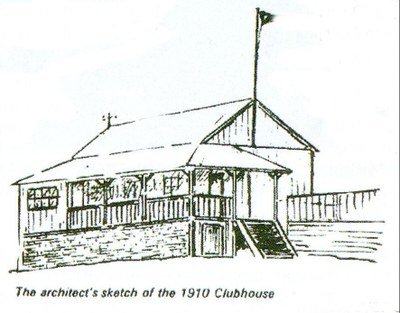 The whole scheme was supervised by the then Captain, A. P. Marks, the Commodore being then largely a ceremonial post. The Edgbaston Branch, according to Storer, was the only one to have an uninterrupted record of racing seasons from its foundation until the outbreak of the First World War. The Club had an Opening Day in 1915 but it said on the racing programme ‘owing to the War no prizes will be issued this year”. At the AGM on 22nd. March 1917 it was agreed as in 1916 “ there should be no official programme and no racing whatsoever on account of the state of affairs prevailing in the Country”.
The whole scheme was supervised by the then Captain, A. P. Marks, the Commodore being then largely a ceremonial post. The Edgbaston Branch, according to Storer, was the only one to have an uninterrupted record of racing seasons from its foundation until the outbreak of the First World War. The Club had an Opening Day in 1915 but it said on the racing programme ‘owing to the War no prizes will be issued this year”. At the AGM on 22nd. March 1917 it was agreed as in 1916 “ there should be no official programme and no racing whatsoever on account of the state of affairs prevailing in the Country”.
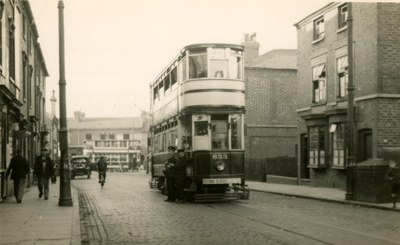 Amazingly only J. Weatherhead lost his life in the war, but Gordon Smith was shipwrecked twice. Nevertheless these must have been amongst the most difficult years in the history of the Club. The late Mike Poole used to recount that he had heard from older members that during the war the boats on moorings at Norton were used as lunchtime target practice by the miners and one by one they sank! Consequently sailing at Norton did not restart and since no sailing was taking place at Barnt Green, it was decided at the AGM in February 1919 to drop the words “Edgbaston Branch” since that was the only part of the Midland Sailing Club left and therefore the whole Club. And so we have our name!
Amazingly only J. Weatherhead lost his life in the war, but Gordon Smith was shipwrecked twice. Nevertheless these must have been amongst the most difficult years in the history of the Club. The late Mike Poole used to recount that he had heard from older members that during the war the boats on moorings at Norton were used as lunchtime target practice by the miners and one by one they sank! Consequently sailing at Norton did not restart and since no sailing was taking place at Barnt Green, it was decided at the AGM in February 1919 to drop the words “Edgbaston Branch” since that was the only part of the Midland Sailing Club left and therefore the whole Club. And so we have our name!

A history of the MSC – Part 4
1917—1930, just after the Great War.
From 1919 until 1922 the Midland Sailing Club prospered very well. Fortunately some photocopied extracts remain of the “Helm”, a forerunner of the Mainsheet, which was professionally printed just after the War. They give a fascinating insight to what the Club was like in 1921—2.
The Regatta was obviously quite something. But by 1923 the post-war boom was over. Membership numbers, energy and participation flagged. The original members were drifting away (L.B.Chatwin set out to be a founder member of Barnt Green), or becoming less mobile. The economic situation did not help and the boats were heavy, relatively expensive and kept on moorings (as shown in the postcard below).

Membership dropped to about 40 and stayed at that level until the 1930’s. Racing still continued and an annual feature was a series of matches against Barnt Green and Sutton Sailing Clubs.
What would the 1930’s bring?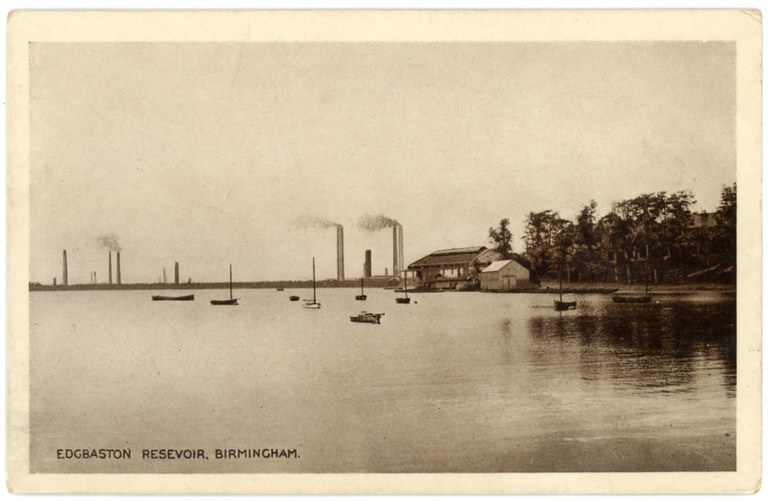
Do not copy or reuse any part of this work without permission of the authors. Postcard of Edgbaston Reservoir courtesy of Mac Joseph www.oldladywood.co.uk. Kindly do not reuse on any website or other publication without the permission of Mac Joseph.